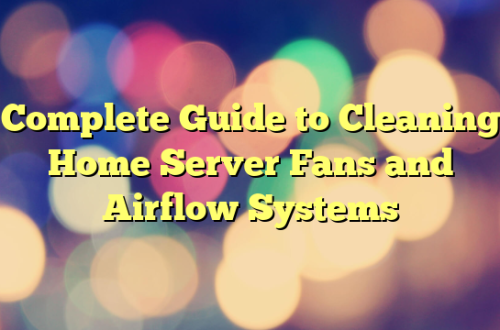When it comes to keeping your home server in top-notch condition, cleanliness matters more than you might think. These machines often run 24/7 and are crucial for data storage, media streaming, home automation, and even business operations. That means dust, debris, and poor airflow can quickly cause overheating, component degradation, or even total system failure.
Keeping your server clean isn’t just about aesthetics—it’s about performance, longevity, and peace of mind.
Why Regular Cleaning Matters
Home servers can collect a surprising amount of dust and grime over time. Unlike laptops or smartphones, they often sit in corners, under desks, or even in closets where airflow is poor and dust settles fast. This accumulation can:
- Block cooling fans
- Cause components to overheat
- Lead to permanent damage to sensitive parts
Risks of Not Cleaning Your Home Server
Letting your server go without maintenance can result in:
- Thermal throttling: Reduced performance due to heat
- Shortened component lifespan: Especially for hard drives, SSDs, and fans
- Data loss: Overheating can cause crashes that lead to file corruption
- Noise issues: Fans working harder and louder
Types of Dirt and Debris That Affect Home Servers
Understanding what you’re fighting against helps in choosing the right cleaning tools.
Dust Accumulation and Its Effects
Dust is enemy number one. It builds up on heat sinks, inside fans, and across motherboards, blocking airflow and acting as an insulator that traps heat.
Pet Hair, Pollen, and Other Particulates
If you’ve got pets or live in an area with seasonal allergens, your server’s components could be coated in tiny fibers and pollen grains, which not only clog fans but can also cause static buildup.
Must-Have Tools to Clean a Home Server
Here’s your essential toolkit. These items are safe, effective, and widely used by IT pros and tech-savvy homeowners alike.
Anti-Static Vacuum Cleaners
Designed specifically for electronics, anti-static vacuums can safely suck out dust without risking electrostatic discharge (ESD). Never use a regular household vacuum!
Compressed Air Cans
Perfect for blasting dust out of tight corners like between heatsink fins or under fan blades. Use short bursts and keep the can upright to avoid releasing liquid propellant.
Microfiber Cloths
Soft and non-abrasive, these are excellent for wiping down exteriors, screens, and vents without scratching the surfaces.
Isopropyl Alcohol (99%)
This high-purity alcohol evaporates quickly and leaves no residue, making it ideal for cleaning thermal paste or grime on circuit boards—just don’t pour it directly on the components.
Anti-Static Wrist Straps
Whenever you’re touching internal components, grounding yourself with an anti-static strap is critical. It protects sensitive electronics from static electricity damage.
Optional Tools That Can Help—but Aren’t Always Necessary
These tools are handy but not essential unless you’re frequently doing deep cleans or running multiple servers at home.
Electric Air Dusters
These reusable devices offer a more eco-friendly (and long-term cost-effective) alternative to canned air. They’re powerful and reduce waste but are a bit noisy.
Specialized Server Cleaning Brushes
Fine-bristled brushes are great for cleaning between circuit pins or within densely packed server units.
Silicone Keyboard Cleaners
These sticky gel-based tools are good for picking up lint and small debris from external keyboards or vent grilles.
Tools You Should Avoid When Cleaning a Home Server
Some tools are more harmful than helpful. Here’s what you should steer clear of.
Household Vacuums
Too powerful and not designed for electronics, these can build static and damage internal components.
Harsh Cleaning Chemicals
Avoid any cleaners that contain ammonia, bleach, or harsh solvents. These can corrode or damage plastic and circuit boards.
Water or Liquid-Based Cleaners
Water and electronics never mix. Even a damp cloth can lead to moisture retention that harms components.
Step-by-Step: How to Safely Clean Your Home Server
Here’s a foolproof method to deep clean your server without causing damage.
Pre-Cleaning Preparation and Safety Tips
- Shut down your server completely.
- Unplug all power sources and peripherals.
- Ground yourself using an anti-static wrist strap.
Cleaning the Exterior Components
- Use a microfiber cloth to wipe down all external surfaces.
- Use canned air to blow out USB ports and vents.
Cleaning Internal Hardware
- Carefully remove the server case panel.
- Blow out dust using compressed air—start from the top and work downward.
- Use a brush for stubborn dust on fan blades and heatsinks.
- If necessary, gently clean circuit boards with a lint-free cloth and isopropyl alcohol.
Final Checks and Reassembling
- Ensure all components are dry and free of debris.
- Reconnect everything securely.
- Power it on and monitor temperatures for a few minutes.
Best Practices to Keep Your Home Server Clean Longer
Room Ventilation and Server Placement
Avoid placing your server near windows, on the floor, or in unventilated closets. Elevate it slightly and allow good airflow.
Regular Maintenance Schedule
Clean your server every 3 to 6 months, depending on your environment. Schedule visual checks monthly.
Top Recommended Products for Cleaning Home Servers
| Tool | Recommendation | Where to Find |
|---|---|---|
| Anti-Static Vacuum | Metro DataVac ESD Safe | Amazon |
| Compressed Air | Falcon Dust-Off Professional | Best Buy |
| Microfiber Cloths | MagicFiber Cleaning Cloth | Walmart |
| Isopropyl Alcohol | MG Chemicals 99.9% | Newegg |
Frequently Asked Questions (FAQs)
How often should I clean my home server?
At least every 3–6 months, depending on dust levels and environment. Monthly visual inspections help catch early signs of buildup.
Can I use a regular vacuum to clean my server?
No. Household vacuums generate static electricity and can damage sensitive electronics.
What parts should never be touched?
Avoid touching the CPU socket, RAM contacts, and any exposed circuitry with your bare hands.
Is it okay to clean while the server is running?
Absolutely not. Always power down and unplug your server before any cleaning.
Are reusable air dusters safe for electronics?
Yes—many are ESD-safe and powerful, but always check manufacturer specs.
How do I know if my server needs cleaning?
Signs include increased fan noise, higher temps, or visible dust through the case vents.
Conclusion: Smart Cleaning, Safe Servers
Keeping your server clean isn’t rocket science—but it does take the right tools and techniques. By sticking with essentials like compressed air, microfiber cloths, and anti-static equipment, you’ll extend your server’s life and avoid costly breakdowns. Avoid shortcuts with the wrong tools, and always follow safe practices when opening up your server.






